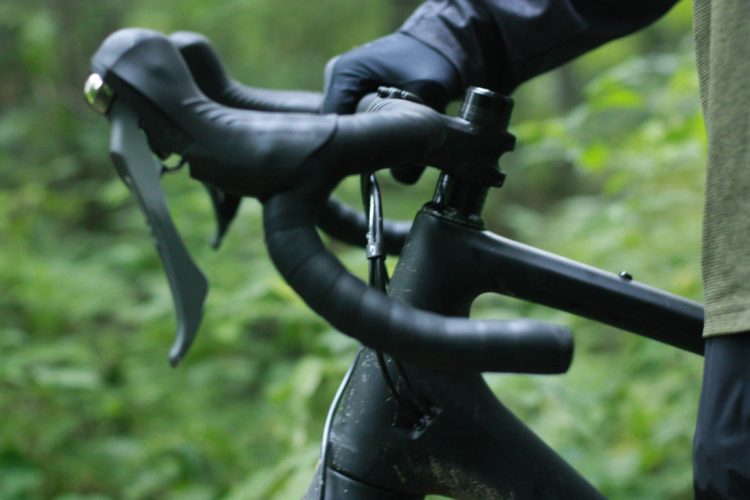
Based in Fürth, Bavaria, Uvex has been in the personal protective equipment business since 1926. Despite their well-known name in helmet manufacturing, Uvex hardly has a stronghold on the MTB helmet market. That said, I could hardly argue with the quality and craftsmanship found in the new Uvex Jakkyl HDE – a full facer with removable chin bar.
Bottom Line: while convertible full face contenders have made it hard to compete, the Uvex Jakkyl HDE packs some serious quality and smart features in one of the lightest (if not THE lightest) helmets with a removable chinbar.
Specifications
- In-mold polycarbonate/EPS construction
- Removable fiberglass chin bar
- Snap-in cheek pads
- BOA tensioning system
- 14 points of ventilation
- Adjustable visor
- Push-button strap closure
- External goggle integration
- Removable and washable lining
- ASTM and CPSC certified (with and without chin guard)
- Weight: 630g-681g
- Sizes: 52-57cm, 56-61cm
- Colors: Black, Blue/Black, Red/Blue
- MSRP: $229 USD
- Details at Uvex Sports

Converting the Chin Bar
So, let’s cut to the chase: how does the chin bar convert? While metal plates joining the chin bar to the upper shell initially draw the most attention, removal actually takes place on two lower, less obvious insertions. Here, tabs on each side of the Jakkyl pivot upwards and then rotate 90º. This unlocks two plastic joints, and the chin bar simply slides out of the upper recesses. With ease, I was able to remove the bar without taking off the entire helmet or my gloves, but replacing it took a bit more coordination. In half shell mode, plastic panels replace the open ports in the absence of the chin bar. This second step and two extra pieces is an inconvenience I would omit over the course of my review.

Fit Features
Sliding on the Jakkyl with chin bar attached was an easy enough task, and the BOA tensioning system has a nice feel at the fingertips. Fit features on the Jakkyl include adjustable locks at the Ys, a rear strap guide through the occipital stabilizer, button-style closure, and three positions for rear stabilizer height. The moisture-wicking inner liner is comfortable, appears very durable, and can be removed for cleaning.
Due to its girth and use of metal hardware, the visor is one of my favorite Jakkyl features. The attachment screws do require a screwdriver, but I rarely find myself messing with visor height. Plus, I find tool-free adjustments more problematic than practical. Peripheral vision was excellent inside the Jakkyl, and there’s plenty of space for goggles, which also benefit from a posterior strap guide.
Comfort
Never mind the number of vent ports on the upper shell alone (Uvex states 14, I count 15), their size and placement worked in concert, providing an extremely breathable ride. This, coupled with the 9 ports on the chin bar, also allowed me to leave the chin bar on for situations you might think unnecessary. I ride in the Pacific Northwest where helmet breathability is not always a top concern, but also took the Jakkyl to Moab this March where a random warm front sent temperatures over 80º F. In short, the Jakkyl breathes so well, you might find yourself riding with the chin bar more on than off.
Why no MIPS?
We asked about the deliberate exclusion of rotational impact technology patented by MIPS and seen in many current helmets. While this is a full-blown discussion in and of itself, according to Uvex, there’s simply not enough current data to support MIPS. What little research is available has been carried out by so few research institutions, it seems imprudent for the time being. Uvex stands by principles of a solid, in-mold construction, well-executed design and fit, and the scalp’s inherent purpose that achieves the same thing as MIPS.
If weight is a concern, you’d be interested to know the Jakkyl HDE is one of the lightest (if not the lightest) convertible full face helmets on the market. The Bell Super 3R and Lazer Revolution weigh over 700g while the Giro Switchblade comes in at 975g. Even the Fox Proframe – a non-convertible full face – weighs over 700g. The Uvex Jakkyl HDE: 630g-681g between the two sizes offered. The most likely explanation for the lack of heft is the Jakkyl’s use of a plastic-locking interface. The competition employs metal hardware in chin bar attachment points. So, here’s a case where lightweight may suffer durability in the long run, yet I found the plastic joints burly with a very secure fit.
With recent developments in convertible full face helmets – each with their own take on chin bar attachment – it’s an exciting time to be in the helmet market. Due to its weight (or lack thereof), solid construction, breathability, and ASTM stamp, I would absolutely throw the Jakkyl high up on the list.
Thank you, Uvex Sports, for the opportunity to review the Jakkyl HDE.















2 Comments
Apr 21, 2017
One request for all helmet reviewers..
Could you please provide fit comparisons with more well known/well stocked brands.
Trying to buy a helmet without trying it is way too costly. And most shops only stock a few brands.
Trying to find a place to try a lesser known is nearly impossible.
For example the bell helmets fit me well, whereas the met helmets leave an inch either side of my temples (for wider noggins).
Given theres about 6 definable head shapes and only one or two brands that identify this some comparisons shouldn't be too difficult.
Thanks.
Apr 21, 2017